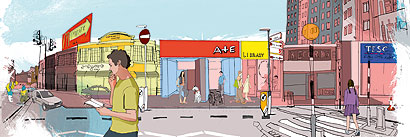|
|
||
|
The traditional heart of British retail is dead. Rather than artificially resuscitating it with low taxes and cheap parking, we need to reinvent our town centres as more than places to buy stuff Walk down almost any British high street and you’ll see shop windows whiting out like the eyes of a dying cartoon character. Familiar retail names are blowing out like a fusing switchboard. Woolworths, Jessops, Comet, Borders, Virgin Megastore. Some of them have even, given the strange zombie world of bankruptcy, gone bust twice. And as they do, there is a collective wailing and gnashing of teeth. It’s as though something fundamental is disappearing before our eyes, as though a part of the intrinsic nature of our cities is dissolving into nothingness. The UK government has responded to the crisis in the only way it knows how: by signing up a TV celebrity for a quick fix. It has hired Mary Portas, once Topshop’s retail wizard, then TV’s “Queen of Shops”. As adviser to the government on high streets, she authored the 2011 report suggesting that empty shops be turned into gyms, crèches and bingo halls, and that a “National Market Day” could drive customers to veg stalls across the land. Now 27 towns have won bids to become “Portas Pilots”, each receiving the grand sum of £100,000 to fix their ailing high streets. Initiatives so far include evening markets and stalls for £10, contributions to business rates to encourage entrepreneurship and providing affordable car parking (only 10p all day on a Sunday in Braintree!). The idea of Potemkin retail reached its apogee during the G8 summit in Northern Ireland this year. Empty shops were spruced up to give media and delegates the impression of bustling, functioning high streets. In Belcoo, the windows of a former butcher’s shop were plastered with stickers depicting a packed meat counter of the kind you might find in Belgravia. Over the road, another empty unit was made over to look like a thriving office supply shop. The Department for Communities and Local Government explains the issues as it sees them: “High streets are recognised as important hubs of social interaction and cohesion, as well as providers of local jobs. They’re a visible indicator of how well, or how badly, a local economy is doing. But our high streets and town centres are facing serious challenges from out-of-town shopping centres and the growth of online and mobile retailing.” Well, yes. Of course internet shopping is changing the way we shop. It’s not only convenience but the unfair advantages of being able to dodge tax linked to actual physical space. The big internet retailers often locate the site of their transactions in low tax zones. Without retail premises, they also avoid business rates. Internet retail disrupts the way we buy and simultaneously circumvents the traditional flows of local economies and council revenues. And of course, the wider economy will affect things too. As wages stay flat, so too does consumer confidence – and retail remains in the doldrums. It’s true to say that there are pockets that rebuff the prevailing conditions. Walk down the high streets of London’s wealthier or more fashionable areas and you might think you had been transported back into some kind of idealised 1950s scene. Here tiny shop after tiny shop with their brightly painted fronts display a range of cute specialisms. Cheese shops, cookware, knick-knacks that defy categorisation. These are gentrified fantasies, nostalgic re-runs. More like heritage centres, they are make-believe places re-enacting a hazy idea of the high streets we’ve long lost, places where we can occupy a dreamy flashback to the idea of community that the high street represents in the popular psyche. The only real problem is that these places don’t sell anything we actually need. For that we have to go to Tesco. Is the high street really something that can be fixed with a lick of paint and a couple of new benches? Or is it a symptom of a larger shift in the nature of our cities? A reversal in the polarity of cities wouldn’t be unique. Every generation sees a shift. The inter-war suburbs, for example, provided an escape from the slums of the industrial city only for the very same slums to become the homes of the babyboomers returning in waves of gentrification. We might argue that it’s not the city itself that changes but the way we think of and use it. With this in mind, perhaps the crisis on the high street is only really a crisis if you look at it from one direction. What exactly are we mourning when we lament the collapse of the high street? Are we really mourning the idea of the centre of towns filled with people buying things, handing cards and cash over counters in exchange for stuff? Is it really such a disaster that we might not be waddling down high streets with plastic bags stuffed with new things we barely need? The holes in the urban fabric are as much an existential crisis as they are an urban problem. Cities are an image of society, projected into a material and spatial entity. It disturbs us on a fundamental level that the core of our civic identity might be disappearing. These vacated centres seem somehow to be a product of our own internal hollowness, as though the city itself were mirroring our own private psychological implosions. Our despair is only heightened by the fact that we conflate retail and society. Powered by complex cocktails of coffee- derived fluids and strangely sweaty-yet-dry muffins, transaction after transaction, exchange after exchange makes it feel as if we are participating in the public life of our communities. Never mind that these transactions and exchanges are simply abstract electronic transfers mediated by global payment management systems. If the old model is over, we need to imagine new ways of constructing places where we can come together: new uses, new rituals and new ways to pay for them. The developer Cathedral is working on projects for new communities in places including Canning Town, Bromley and Deptford. Richard Upton, its chief executive, explains that the growth of the private rented sector provides a new basis for imagining how and why community, living, retail and a whole range of other activities might coalesce. He argues that if a developer retains the freehold rather than selling its apartments as fast as it can, then the way that value is created changes. The long-term viability of a development as a place becomes important. Simply put, the happier people are in the place they live, the lower the running costs for the developer. The more successful the life within it, the greater the value created. He cites examples such as Cadbury’s Bournville, a place where 19th century altruism combined with industrial progress. What’s important in attitudes like Upton’s is that the high street is seen as part of a holistic idea of the city, not an isolated incident. Rather than “fixing” the high street, it suggests reconceiving it. In his example, the higher value of residential can support the lower value of commercial space. But in turn, the quality of life that that commercial space offers can bring a “halo” effect to the value of the residential. This idea suggests that a far wider spectrum of activities and services could fill the voids in our town centres. Something far richer, more inclusive and democratic and, importantly, riskier than the stuff we are currently lamenting and trying to patch up. Certainly more exciting than traipsing around a Woolworths wondering why pick’n’mix would rub shoulders with sieves and DVDs. The US is a place where the idea of the empty centre is practically written into the constitution (all the while dreaming of white clapboard Main Streets). With a few exceptions, it is obsessed with the supposed freedoms of suburbia. This leaves its trace on the already dispersed centre of the American town, leaving empty big-box retail buildings of the recent past. In places, these former shops have become schools. The Westminster Mall in southern California, for example, has a community day school rubbing shoulders with a Macy’s and a JC Penney. And this non traditional school environment provides a place that better suits non-traditional students. This suggests that traditional planning definitions of “mixed use” are blander than we currently imagine. A more radical and denser mix of uses could defibrillate local economies while forging a new sense of community and place. In William Morris’s science fiction novel News From Nowhere (1890), the Houses of Parliament have been converted into a manure store. At first, the idea of the seat of government shocks our time- travelling hero. But it’s explained to him that manure, in the post-industrial agrarian fantasy of Morris’s novel, is such an important substance that it’s far from a joke or insult. It is this kind of shift that we need if we are to reimagine the possibilities of our town centres. In fact, there might be a time when it’s hard to imagine we gave so much important space to retail. Instead, it could (should even) be those things that really hold us together that sit centre stage. Public facilities, so often isolated from the communities they serve, could become public in the urban sense. Hospitals, due to historic planning legislation, have been islands adjacent to their constituency rather than connected peninsulas. Schools and universities have also, for perceived issues of safety and ease, management and control, remained distinct from the cities around them. As their borders merge, a more symbiotic relationship is established: the city becomes the classroom and the classroom becomes the city. The high street might not have a future as a place just to buy things. Instead, with imagination, it could become a place to engage, to learn, and to really participate. A host to the real mechanisms of society rather than places we go to buy the sensation of participation.
|
Words Sam Jacob
Images Patrick Morgan |
|
|
||




















